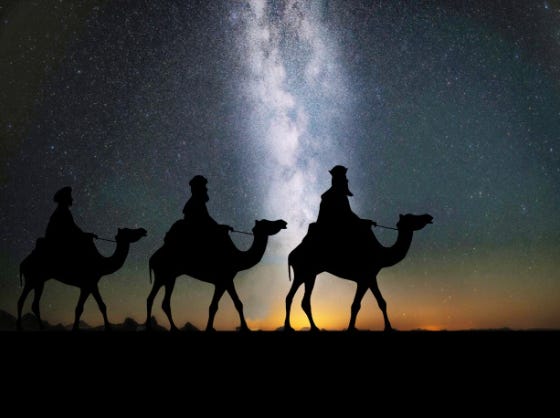Special Patrons of Travellers
The bones of these three holy “kings” are now believed by some to rest in Cologne cathedral
THE THREE WISE MEN (First Century)
That the Wise Men or Magi were three in number, though this is not directly stated in the gospel, appears to be a tradition of great antiquity, founded, no doubt, upon the fact that three kinds of gifts are specified. They are represented as three in some of the oldest catacomb paintings (though there are a few exceptions, in which we find two, four, and even six—apparently from a motive of artistic symmetry), and several of the fathers—e.g. Origen (Hom. in Genesim, xiv 3), St Maximus of Turin, and St Leo—seem to take the number three for granted. The fact that the adoration of the Magi is often balanced against the Old Testament scene of the three youths in the fiery furnace may also have helped to stereotype the convention.
In the catacomb frescoes and sarcophagus sculptures of early date the Magi are always depicted as wearing Phrygian caps. The idea of their royal character developed later, being probably suggested by the wording of Psalm lxxi 10: “The kings of Tharsis and the islands shall offer presents; the kings of the Arabians and of Saba shall bring gifts.” It seems to occur first in a sermon attributed to St Caesarius of Arles (Migne, PL., vol. xxxix, c. 2018), who died in 543; anyhow, from the eighth century onwards we find them in Christian art commonly represented with crowns.
Still later the Magi acquire definite names. A Paris manuscript of the eighth century calls them “Bithisarea, Melchior and Gathaspa”; in a miniature of the Codex Egberti (c. 990) we find written against two of them “Pudizar” and “Melchias”. Despite these prima-facie divergences, there can be no doubt that these represent some common form from which have come the Balthasar, Melchior and Caspar now popularly received. In the later middle ages one often notices that in pictures of the Magi one is represented as a youth, another as an old man, and the third as middle-aged. Lastly, the practice of painting one of them as a Negro only developed in the fifteenth century.
The bones of these three holy “kings” are now believed by some to rest in Cologne cathedral, in a shrine which is one of the finest examples of the craft of the medieval metal-worker. There is no reason to doubt that these relics are identical with those which were brought to Cologne in 1164 from the basilica of St Eustorgius at Milan, having been given to the archbishop of Cologne by Frederick Barbarossa. But the earlier history is much less satisfactorily attested, although the identification of the relics at Milan with those of the three kings may probably be traced back to the ninth century. The bones are said to have come to Milan.
From Constantinople, possibly in the time of the Emperor Zeno (474–491), but we know nothing of how they were identified with the kings nor of how they got to Constantinople. No one can dispute that the three kings were enthusiastically venerated, especially in Germany during the middle ages, the devotion being probably fostered by the many pilgrimages made to their shrine at Cologne and by the mystery plays in which the coming of the Magi to Bethlehem was a favourite theme. They were naturally often venerated as the special patrons of travellers.
From Butler’s Lives of the Saints



